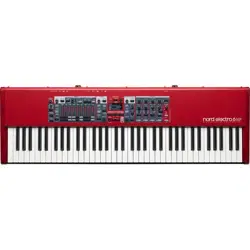Loading ...
Loading ...
Loading ...

4. ORGAN | 11
SELECTING AN ORGAN MODEL
Use the ORGAN MODEL selector button to select your
preferred Organ model: B3, VOX, FARF, PIPE1, PIPE2
or B3 BASS.
With the B3 Bass setting, its drawbars are placed on
the “upper” manual in non-Dual Organ mode, mak-
ing it possible to create B3 Bass and Piano/Sample
Synth splits. In Dual Organ mode the bass drawbars
are found on the lower manual, with a standard set of B3 drawbars on
the upper manual.
THE B3 MODEL
The B3 model is a digital model of the classic electro-mechanical tone-
wheel organ. This simulation utilizes innovative and advanced methods
to capture every nuance of the original sound. Here are some examples:
• An extremely accurate digital model of the original chorus and vibrato
scanner.
• Modeling of the individual random contact bounces for each
harmonic.
• Modeling of the unique frequency characteristics of the built-in
pre-amplifier, which forms the “body” of the sound.
• Simulation of the energy robbing on the tone wheels that results in the
typical “compressed” sound.
• Authentic tuning of the tonewheels according to the original design.
• Extremely fast keyboard response.
• Full polyphony.
B3 DRAWBARS
The harmonic intervals for the B3 tonewheel organ are printed on the
panel below the drawbars.
For basic drawbar operation, please refer to “Drawbars and Buttons”
on the previous page. Each drawbar represents a partial with a fixed
harmonic interval in relationship with the played note.
The illustration below shows the pitch interval among the nine drawbars
when the key of C3 is played. Note that the 5 ⅓’ drawbar is a 5th above
the fundamental harmonic (8’) but in many situations is perceived as
sounding below it.
VIBRATO & CHORUS
The original vibrato and chorus scanner in a tonewheel organ consists
of a modulated delay line in combination with a rotating scanner. For the
Vibrato effect, phase shift is applied to the signal. For the Chorus effect,
the phase-modulated signal is added to the original signal.
Three different types of choruses (C1 - C3) and three different types of
vibratos (V1 - V3) are available. Select one of these types by pressing
the Vibrato/Chorus selector button.
PERCUSSION
Press the PERCUSSION ON button to add an extra attack to the B3
sound by having a single envelope generator controlling either the 2nd
or 3rd harmonic.
The envelope “opens up” for a short moment in the beginning of the
sound when you press the key(s).
The percussion is a single-triggered non-legato effect. By “single-trig-
gered” we mean that the percussion is only present when you hit the
keys when no other note is sounding. In other words, if you play a note
or a chord and then add more notes without releasing the previously
pressed keys, there will be no percussion effect in the new notes. You
have to release all keys to be able to play new notes with the percussion
effect.
The SOFT button toggles between Normal and Soft percussion level.
The FAST button toggles between Slow and Fast decay times.
The THIRD button toggles between using the 2nd or 3rd partial as the
source for the percussion effect.
M The Percussion effect is only available for the B3 organ model.
KEY CLICK CONTROL
The key click produced by the random contact bounces is an impor-
tant audio artifact in the original B3 instrument and quickly became a
desirable effect among musicians. The click level can be adjusted in the
Sound menu, read more about this on page 28.
Do not forget to try out the three tonewheel modes that are also
available in the Sound menu. These will dramatically change the
sound of the B3 model from a squeaky clean unit to a battered, old
workhorse.
C3
16 5
⅓ ⅔ ⅗
8 4 2 1
⅓
1 1
2
Loading ...
Loading ...
Loading ...
